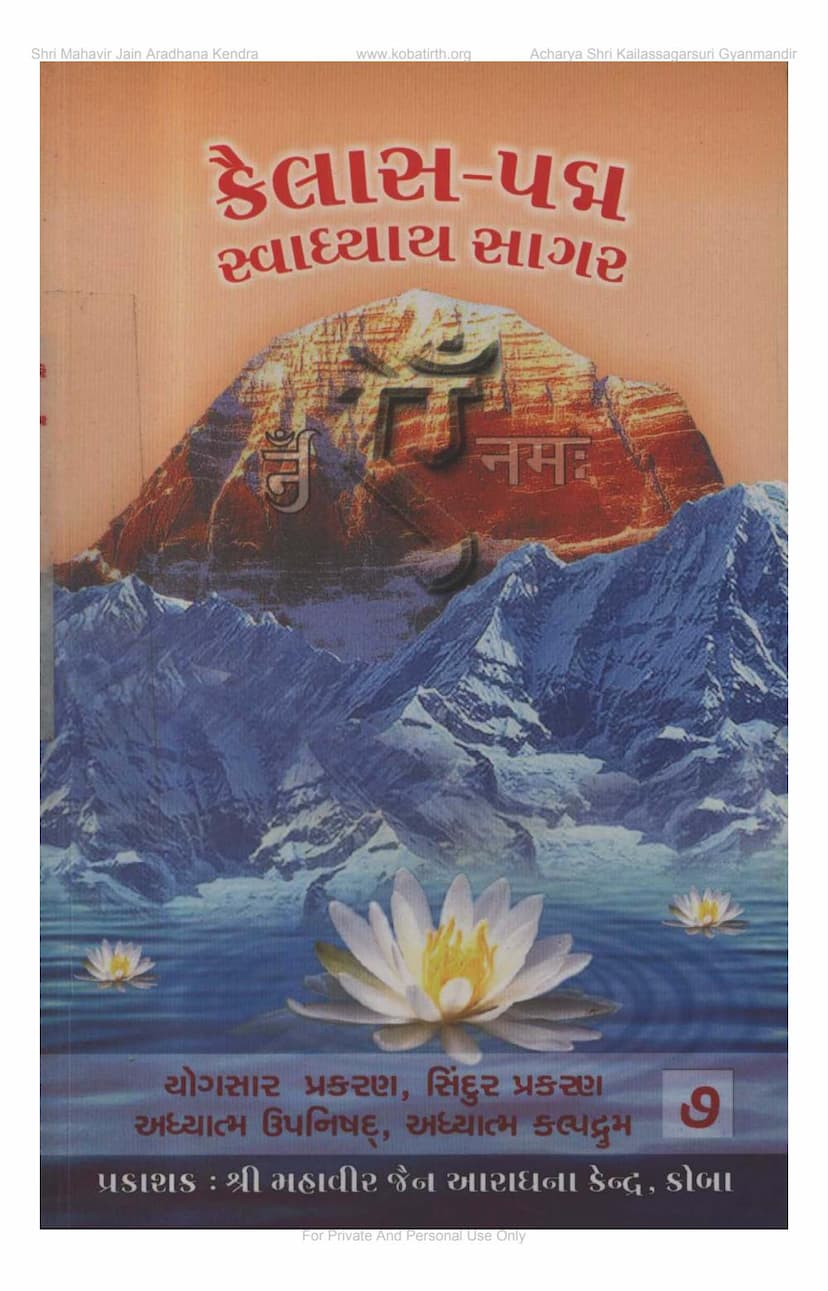Kailaspadma Swadhyayasagara Part 7
Added to library: September 2, 2025

Summary
Here's a comprehensive summary of the provided Jain text, "Kailaspadma Swadhyayasagara Part 7," based on the pages you've supplied:
Overall Context:
"Kailaspadma Swadhyayasagara Part 7" is a Jain religious text published by Shri Mahavir Jain Aradhana Kendra, Koba. It is part of a larger series titled "Swadhyaya Sagar" (Ocean of Self-Study). This particular volume is dedicated to spiritual teachings and practices, featuring several key philosophical and yogic texts. The publication is presented as a tribute to revered Acharyas and a means to facilitate spiritual learning and progress for monks, nuns, and sincere seekers of spiritual knowledge.
Key Components and Themes:
The book appears to contain a collection of significant Jain philosophical and spiritual works, likely presented with commentary or exposition. Based on the table of contents and the initial pages of the texts, the primary sections are:
-
Yogasara Prakaran (Chapter on the Essence of Yoga): This section delves into the core principles of yoga as understood within Jainism. The introductory verses emphasize the importance of meditation on the Vitaraga (the detached, omniscient beings) for self-purification and attaining the highest state. It highlights that the soul's purity is revealed as its impurities (kashayas) are removed, leading to a state of equanimity and ultimate liberation. The text stresses the role of equanimity (samya) in achieving spiritual progress and describes the nature of the pure soul as formless, conscious, and blissful, residing in the liberated state. It also touches upon the necessity of following the teachings of the Tirthankaras and the path of right conduct (charitra).
-
Sindura Prakaran (Chapter on Sindura): The title "Sindura" (vermilion) might be symbolic, possibly representing something that purifies, illuminates, or signifies auspiciousness in the spiritual journey. The content, as glimpsed in the provided verses, discusses the attainment of spiritual knowledge, the futility of worldly pursuits without dharma, and the destructive nature of passions like anger, pride, deceit, and greed. It emphasizes the importance of righteousness and adherence to the teachings of the Tirthankaras.
-
Adhyatma Upanishad (Spiritual Upanishad): This section appears to be a significant philosophical treatise focusing on the nature of the soul and the path to spiritual liberation. The verses highlight the importance of discerning the true self from the physical body and worldly attachments. It discusses the ephemeral nature of worldly pleasures and the suffering caused by desires. The text seems to advocate for detachment, equanimity, and self-realization as the means to overcome the cycle of birth and death. It also touches upon the nature of the omniscient beings (Vitaragas) and the path of non-violence and detachment.
-
Adhyatma Kalpadruma (Wish-Fulfilling Tree of Spirituality): This text likely elaborates on various spiritual principles and practices that lead to liberation. The title suggests a comprehensive guide to spiritual attainment, covering different aspects of spiritual discipline and knowledge. The content seems to emphasize the importance of right faith (samyak darshan), right knowledge (samyak gnana), and right conduct (samyak charitra) as the path to the ultimate goal. It also likely discusses the nature of Karma and its effects on the soul.
-
Chhandashastra (Science of Prosody/Metre): This section is dedicated to the study of poetic metre and composition. It provides definitions and descriptions of various Sanskrit metres (like Anushtubh, Arya, Shalinī, Vasantatilaka, etc.) with explanations of their structure in terms of syllables (laghu and guru) and patterns. This suggests that the spiritual texts within the book are likely composed in these traditional poetic forms, and this section serves as a guide to understanding their prosody.
Dedication and Acknowledgements:
- The book is dedicated to Rashtrasant Acharya Shri Padmasagarsurishwarji on the auspicious occasion of his 52nd anniversary of renunciation (sanyam jivan) and his 72nd birthday.
- The compilation and editing are credited to Muni Shri Padmaratnasagarji.
- The work is inspired by the blessings and guidance of several esteemed Acharyas, including Yoganishtha Acharya Shri Buddhisagarsurishwarji, Charitrachudamani Acharya Shri Kailassagarsurishwarji, and Shilpashastra-jnya Acharya Shri Kalyansagarsurishwarji.
- Specific individuals are acknowledged for their contributions to the text, including Muni Shri Trilokysagarji (for compilation), Muni Shri Hemchandrasagarji, Muni Shri Nirvanasagarji, and Muni Shri Ajaysagarji (for proofreading and guidance), and various lay individuals and supporters.
Core Spiritual Message:
The overarching message of "Kailaspadma Swadhyayasagara Part 7" is to guide individuals towards spiritual liberation (moksha) through self-study (swadhyaya), meditation, detachment, and adherence to Jain principles. The texts emphasize:
- The Supremacy of the Soul: The true self is the soul, distinct from the body and worldly possessions.
- The Importance of Equanimity (Samya): Maintaining a balanced state of mind, free from attachment and aversion, is crucial for spiritual progress.
- The Removal of Passions (Kashayas): Anger, pride, deceit, and greed are the primary obstacles to liberation and must be overcome.
- The Power of Knowledge and Meditation: Through right knowledge and deep meditation on the Vitaragas, the soul can achieve its pure, liberated state.
- The Path of Renunciation and Austerity: Detachment from worldly desires and practicing austerity are essential for spiritual growth.
- The Guidance of Acharyas and Scriptures: Following the teachings of enlightened gurus and sacred scriptures is vital for navigating the spiritual path.
In essence, this volume is a rich collection of spiritual wisdom, aimed at illuminating the path to self-realization and ultimate freedom within the Jain tradition.